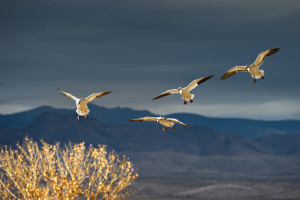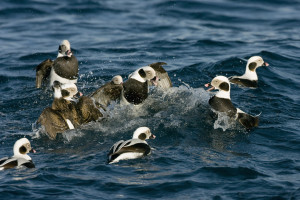
Harlequin Duck (Histrionicus histrionicus)Iceland June 2006
Many would agree that autofocus changed the world of bird photography. Before autofocus, focusing was done manually and the photographer had to rely heavily on his eyesight. This made taking sharp images of birds in close range very difficult, resulting in poor images. Now, with autofocus, photographers have the ability to capture one great shot after another. However, there are circumstances where one-shot focus does still apply.
Below are tips for perfecting your focus when photographing birds

Designate and Keep a Specific Autofocus Point: When using continuous focus try to keep a chosen AF point, or points, locked on the subject. This allows the camera processor to calculate and estimate the subject’s flight path. By doing so, you will enjoy a long series of sharp images after photographing a flying bird.
Make Appropriate Lens Adjustments: When photographing birds, selecting the right working distance on your lens is an essential yet basic lens adjustment. If you are photographing flying birds, select the option with a focusing range from the largest available number of feet to infinity. This allows for faster focusing. When photographing a fast bird against a busy background, your best bet is to select the slowest or second slowest tracking sensitivity. This helps keep the focus steady and prevents the camera from switching focus to the background.
Use More than One Autofocus Point: Birds that fly in erratic paths can be very difficult to capture and track down. In these situations it is best to set up multiple AF points. Try using an extended central AF point (four or eight extra points). That way, if the central AF point loses the subject, the additional AF point can lock onto it.
 Utilize One-Shot Focus for Birds That are Standing Still: One-shot focus means aiming your AF point at the desired spot and pressing the shutter release halfway down. This allows the camera to focus on the spot and lock it. With this focusing method, you can either take several frames with the same focus by pressing shutter release all the way down, or you can move your camera to reframe for better composition before pressing the release fully down
Utilize One-Shot Focus for Birds That are Standing Still: One-shot focus means aiming your AF point at the desired spot and pressing the shutter release halfway down. This allows the camera to focus on the spot and lock it. With this focusing method, you can either take several frames with the same focus by pressing shutter release all the way down, or you can move your camera to reframe for better composition before pressing the release fully down
Use the Largest Possible Aperture for Close-ups: When taking close-ups it is best to use the largest possible aperture, especially when the focus area is very shallow. To ensure that you will get a good shot of the subject, focus on the target several times and take multiple frames.
Anticipate the Action Area with One Shot-Focus: One-shot focus works best when there is little chance that you will need to track the subject. Try prefocusing on a nest hole entrance and setting your lens focus to manual. When you see the bird getting close to the nest, take a series of images. Typically this ensures that at least one frame has caught the bird in the favored position. This will yield better results than continuous

From The Handbook of Bird Photography by Marcus Varesvou
Want to read more like this? Check out Rocky Nook’s book, The Handbook of Bird Photography by Markus Varesvuo, Jari Peltomaki and Bence Mate
